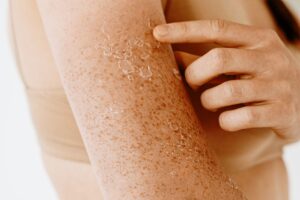A cleft chin is an indentation or Y-shaped crease right in the center of your chin. It usually forms as a result of DNA and inherited facial characteristics as the fetus develops in the womb. Embark on a transformative journey to enhance your facial features as we delve into effective treatment for cleft chin. Unlock the secrets to a more confident and defined jawline.
This condition has no practical function and mostly considered cosmetic. It can, however, augmented or reduced in appearance using plastic surgery.
Table of Contents
1. Dermal Fillers
For individuals with a cleft chin that isn’t severe, chin fillers can be a great option. This procedure involves a cosmetic surgeon injecting a synthetic filler into the soft tissue under the skin to correct chin issues. The injections are quick, safe, and reversible if you have negative side effects. You can expect the results to last for up to six months or more.
There are a variety of dermal fillers available in different types and strengths. Your doctor will determine which product is best suited for your needs during a consultation. Some popular options include Juvederm, Restylane, and Radiesse. While many dermal fillers can used for chin augmentation, it’s important to choose a practitioner who is highly experienced with this type of procedure. Inexperienced practitioners may use too much filler, which can create unnaturally enlarged or distorted facial features.
During a cleft chin filler treatment, the skin specialist will apply numbing cream to the area if necessary. Next, they’ll mark the area and begin to inject the filler using a cannula technique for smooth contouring and to reduce the risk of bruising. The treatment can take as little as 15-30 minutes to complete. Once the procedure is complete, it’s recommended to use ice packs for the first day to help minimize swelling and bruising. You should also avoid strenuous exercise and intense heat to prevent the filler from moving around or dissolving prematurely.
While chin fillers can use to address a wide range of aesthetic problems, they’re most effective in correcting chin dimpling. This can cause by a double chin, recessed chin, or a lack of definition in the jawline. The treatment can also enhance the appearance of a weak chin to help create a defining line between the chin and neck.
Chin fillers can also balance out asymmetry by reshaping the face. Asymmetry is common and can caused by a number of factors including facial structure, surgery, or birth defects. Asymmetry can have serious mental and emotional repercussions that can easily addressed with chin fillers. This procedure is ideal for people who want to improve their self-esteem or look more attractive.
2. Fat Grafting
Like hair or eye color, a dimpled chin is a genetic trait that’s fairly common. If both of your parents had a dimpled chin, you’re more likely to have one too. It’s not a big deal, but it may be a bit of an annoyance if you feel like it makes you look unattractive or if others find your chin a turn-off.
Fortunately, there are several cosmetic solutions that can make your chin look more attractive without requiring surgery. Dermal fillers are ideal for a cleft chin because these injections made of hyaluronic acid, which can increase skin volume and make it look fuller. The first filler to be FDA-approved for the chin was Juvederm Voluma in 2020, but injectors were using fillers off-label for this purpose long before that.
Another option is fat grafting, which uses your own natural fatty tissue to fill in the area of your chin with a more permanent result. Liposuction is use to harvest and purify the fatty tissue, which then gets injected into the chin. This can also help if you have a receding chin, jowls or jawline that needs more definition. Combined with Botox, this procedure can be even more effective for reducing the appearance of a retruded chin.
There are other surgical options for your chin as well. These procedures can reduce your chin bone height or adjust the placement of your chin muscles for more defined results. While these procedures are more invasive and less quick to recover from than fillers, they provide a much more permanent result.
For the best results when treating a chin cleft, it’s important to find a board-certified or board-eligible plastic surgeon with plenty of experience performing these kinds of procedures. You can search for an ASPS-certified or -eligible plastic surgeon near you by using our Find A Surgeon tool. You can also schedule a consultation with the surgeon to determine which treatment will give you the most beautiful and natural-looking results. Contact us today to schedule your appointment!
3. Botox
Botox is another nonsurgical option for reducing the appearance of chin dimples or clefts. The injections relax the muscles that cause these indentations for a smoother contour. While it’s not a solution for everyone, this injectable is safe for most patients and can provide great results that last about a year. You can expect your chin to feel firm for a few days after your injections while natural inflammation resolves. It is important to avoid rubbing or massaging the area, however, as this could potentially spread the toxin to an unintended target.
Botox works by blocking nerve impulses that are responsible for muscle movement. When injected into the chin, the neurotoxin causes the muscles to stop contracting, which eliminates the indentations and makes the skin appear smoother. The procedure can do quickly and safely, requiring only a few minutes in the office. Before the treatment for cleft chin, your doctor will apply a topical anesthetic to numb the injection site. Then, the doctor will carefully place a series of small injections in the chin area. These often delivered in a grid pattern to ensure that the entire chin treated.
The result is a noticeable reduction in the size of your chin cleft. Unlike dermal fillers, this option will not plump the area or add volume. Instead, it will simply reduce the prominence of the cleft, giving your face a more chiseled look. The best candidates for this treatment are those who want to reduce the appearance of a chin cleft without undergoing surgery.
If you have a very pronounced chin cleft, you might consider surgical options such as genioplasty to change the shape of your jaw bone and reposition the chin muscles. This treatment is typically more expensive than a nonsurgical alternative, but it can yield permanent results that not affected by future weight fluctuations or facial changes.
Although a chin cleft is determined by genetics, it can also be the result of excessive flexing of the chin muscle (mentalis). If you have this condition, you may notice that the indentations in your chin are more prominent when you smile or laugh. Botox and hyaluronic acid dermal fillers are effective treatments that can help minimize the appearance of this flaw for a more defined chin.
4. Surgery
Cleft chins are a very common facial feature that may cause by genetics or by the way the muscles of your chin develop. They usually appear as a prominent indent in the middle of your chin. Unlike dimples, which created by muscle contractions or pressure, a cleft chin is an actual underlying bone structure that relates to the incomplete fusion of your chin bone and the mentalis muscles.
While a chin cleft is typically something that occurs while growing in the womb, it’s also possible for both men and women to have it develop after birth. Cleft chins are a genetic facial characteristic and can passed on from parent to child through an autosomal dominant gene. However, this does not mean that if one parent has a chin cleft, their child will have one as well, as genetics is very unpredictable.
If you’re looking to permanently correct a chin cleft, there are several surgical options available to you. The least invasive option is to have your cosmetic surgeon inject synthetic fillers into the chin cleft as an outpatient procedure that takes only a few minutes and is reversible. If you want a more permanent solution, your doctor can perform fat grafting to help fill the chin cleft. For this, a tiny amount of your own fat removes through liposuction, refined, and then injected into the chin area.
The most invasive surgery is called genioplasty, which involves modifying your jaw bone and adjusting the position of your chin muscles. A chin implant may use in conjunction with this technique for more pronounced results. This is the best option for a cleft chin that’s difficult to fix through less invasive methods, but it does require a longer recovery period.
If you’re interested in treatment for your chin cleft, schedule an appointment with a board-certified plastic surgeon near you. Use the American Society of Plastic Surgeons’ Find A Plastic Surgeon tool to locate a surgeon in your area. They can help you determine which procedure is the most appropriate for your needs and goals.








